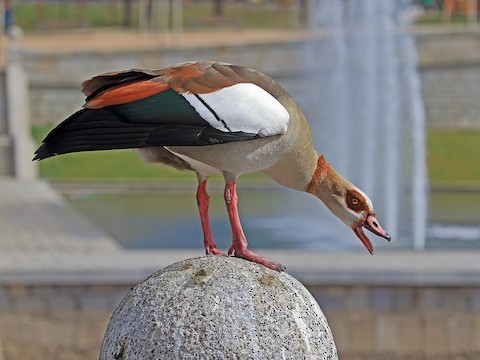Birdfinding.info ⇒ Common across much of eastern and southern Africa, and increasingly as an introduced, urban species in Europe and the U.S.—where it has become very numerous in Greater Los Angeles and southeastern Florida.
Egyptian Goose
Alopochen aegyptiaca
Sub-Saharan Africa; widely introduced elsewhere.

Approximate natural distribution of the Egyptian Goose. © BirdLife International 2018
Occurs naturally in wetlands and surrounding grasslands across most of sub-Saharan Africa, but increasingly limited to the east and south, declining elsewhere.
The bulk of its remaining natural range extends from east-central Sudan, northern Eritrea, and Djibouti south through Ethiopia, western Somalia, and the East African savannas, then generally throughout southern Africa from southern Angola and Zambia southward.
In western and central Africa, it was formerly present throughout the Sahel, but has been reduced to a few localized remnant populations: in bottomlands of the Senegal River; coastal Guinea-Bissau; and central and southern Chad. Another isolated remnant population persists in the Nile Valley of Egypt.
Elsewhere across its former range, there are a few recent records scattered from Burkina Faso to the Central African Republic.
In Europe, introductions began in the 1700s in southern England. By the 2020s, introduced populations are well-established across most of western Europe from northern England and southern Sweden south to the Iberian Peninsula, and in central Europe east to western Poland and south to the Alps. Wanderers from these populations are increasingly frequent in south-central and southeastern Europe from Italy and Slovakia to Turkey, so its range expansion appears to remain ongoing.
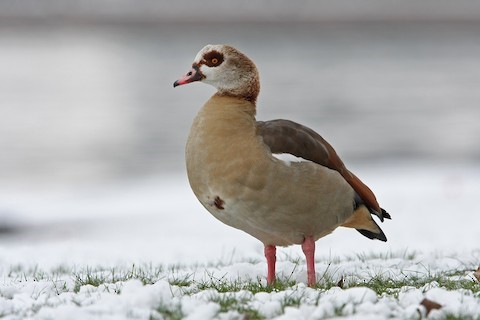
Egyptian Goose in the snow of central Europe in mid-winter. (Frankfurt, Germany; January 6, 2010.) © Christoph Moning
In the Middle East, introduced populations are well-established in Israel and southwestern Syria, and in the U.A.E. from Abu Dhabi to Ajman. Wanderers from these populations have been found in neighboring countries, suggesting that further expansion in progress.
In the U.S., introduced populations are well-established and expanding rapidly in southern California (Los Angeles and Orange County), central and eastern Texas (eastern Edwards Plateau east to Houston and south to Corpus Christi), and peninsular Florida (north to Ocala and Daytona Beach). A smaller population may be becoming established in northwestern Arkansas. Wanderers have been found north to central California, eastern New Mexico, and eastern Kentucky, and south to the Bahamas.
Identification
Unique and unmistakable: a large, sand-colored goose with an irregular dark reddish-brown patch around each eye, a rusty collar and wash on the neck, and patches of dark-brown, coppery-brown, white, black, and glossy-green or purple on the upperparts and wings. The legs are bubblegum-pink.
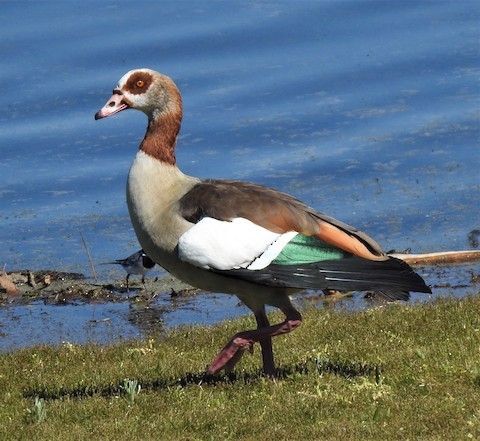
Egyptian Goose, showing a glossy-green sheen on the secondaries and a coppery sheen on the scapulars. (Encoro de Cecebre, A Coruña, Galicia, Spain; April 17, 2021.) © Lois Santos Pérez
Some individuals have extensive white on the face, some have more dark-brown around the base of the bill, matching the eye-patch color. The eyes are pale-orange, contrasting with the eye-patch.
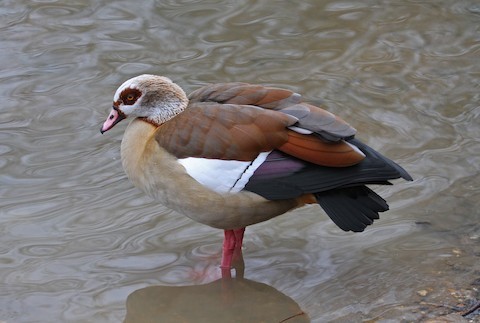
Egyptian Goose, showing a purplish sheen on the secondaries and a coppery sheen on the scapulars. (Bedfont Lakes Country Park, Surrey, England; December 31, 2018.) © Paul Lewis

Egyptian Goose, showing bubblegum-pink legs. (Ardales, Málaga, Andalucía, Spain; May 31, 2021.) © Ricky Owen
The bill is mostly pale-pink or whitish on the upper mandible and red around the edges and lower mandible, with black at the base, around the nostril, and on the nail at the tip.
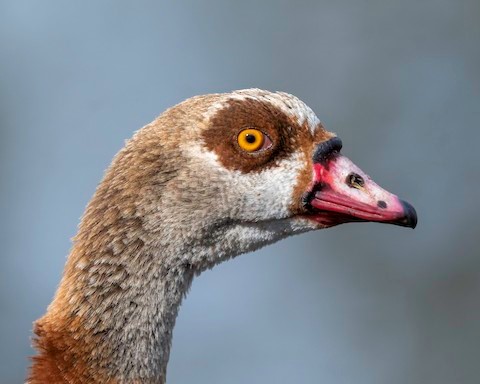
Egyptian Goose. (Brackenridge Park, San Antonio, Texas; March 4, 2021.) © Keith Dickey
In flight, the wing appears mostly black with all-white coverts (above and below) and a greenish or purplish gloss on the upperside of the secondaries (lighting-dependent).
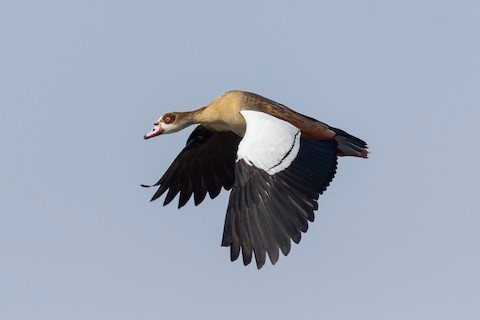
Egyptian Goose in flight, showing black upperwing with white coverts. (Al Qudra Lakes, Dubai, United Arab Emirates; December 2, 2021.) © Vishnu Vinod

Egyptian Goose in flight, showing black underwing with white coverts. (Chamo Lake, Ethiopia; January 8, 2011.) © Lars Petersson
Notes
Monotypic species.
More Images of the Egyptian Goose

Egyptian Goose. (Oosterpark, Ridderkerk, Netherlands; December 22, 2021.) © Ad Konings
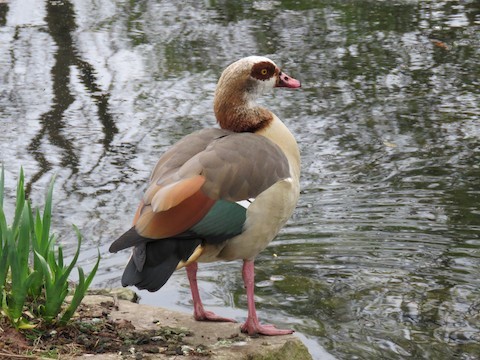
Egyptian Goose. (Kew Royal Botanic Gardens, London, England; March 29, 2017.) © Alan Coates
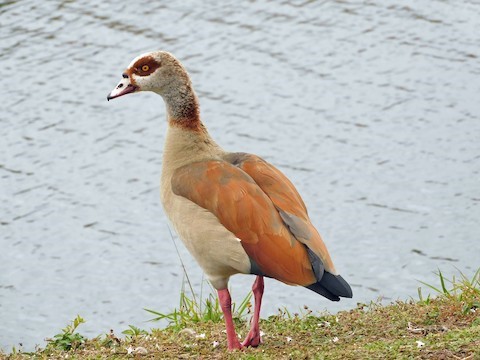
Egyptian Goose, showing mostly coppery-brown upperparts. (Renaissance Commons, Boynton Beach, Florida; January 26, 2022.) © Mark Penkower

Egyptian Goose, gosling. (Porto, Portugal; May 16, 2021.) © Ana Amaral
References
Alderfer, J., and J.L. Dunn. 2014. National Geographic Complete Birds of North America (Second Edition). National Geographic Society, Washington, D.C.
BirdLife International. 2018. Alopochen aegyptiaca. The IUCN Red List of Threatened Species 2018: e.T22679993A131910647. https://dx.doi.org/10.2305/IUCN.UK.2018-2.RLTS.T22679993A131910647.en. (Accessed February 24, 2022.)
Borrow, N., and R. Demey. 2004. Birds of Western Africa. Princeton University Press.
eBird. 2022. eBird: An online database of bird distribution and abundance. Cornell Lab of Ornithology, Ithaca, N.Y. http://www.ebird.org. (Accessed February 24, 2022.)
Redman, R., T. Stevenson, T., and J. Fanshawe. 2009. Birds of the Horn of Africa: Ethiopia, Eritrea, Djibouti, Somalia, and Socotra. Princeton University Press.
Sinclair, I., and P. Ryan. 2003. Birds of Africa South of the Sahara. Princeton University Press.
Sinclair, I., P. Hockey, W. Tarboton, and P. Ryan. 2011. Birds of Southern Africa (Fourth Edition). Random House Struik (Pty) Ltd. Cape Town, South Africa.
Svensson, L., K. Mullarney, and D. Zetterström. 2009. Birds of Europe (Second Edition). Princeton University Press.
Xeno-Canto. 2022. Egyptian Goose – Alopochen aegyptiaca. https://xeno-canto.org/species/Alopochen-aegyptiaca. (Accessed February 24, 2022.)
